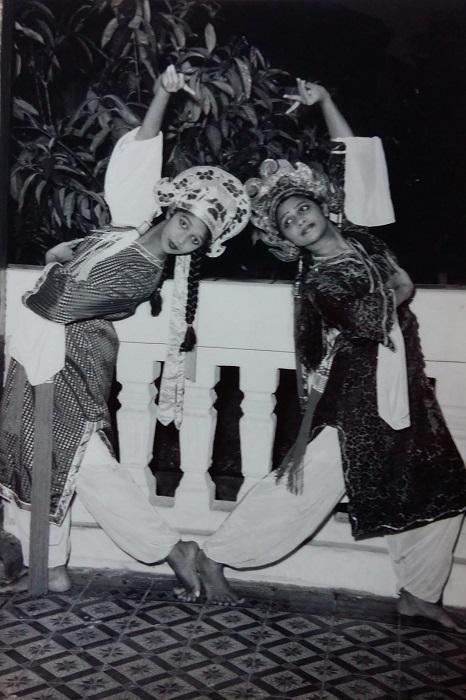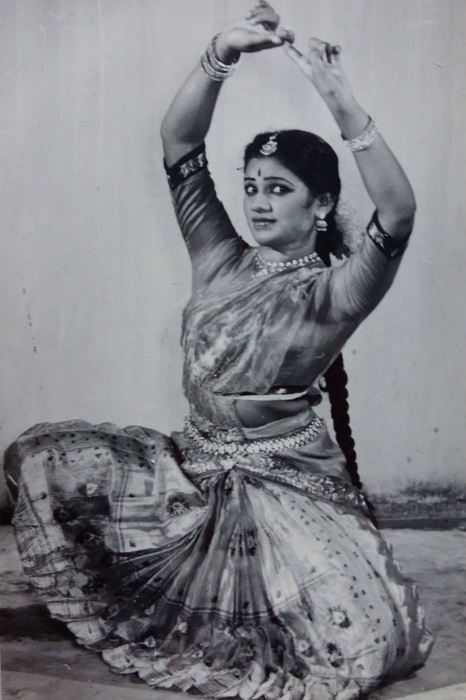
Dancing queen… Mrs Santha Bhaskar’s days as a dancer may be over, but she continues staging Indian dance dramas and contemporary works that are experimental and cross-cultural, reflecting the unique Singapore identity.
WHAT comes to mind when you think of Indian dance? Definitely not quantum physics, mathematics or technology. Yet, those are exactly what acclaimed local Indian dance pioneer, Mrs Santha Bhaskar, creatively incorporates into the dances she choreographs.
The 1990 Cultural Medallion recipient has always taken an inventive approach to Indian classical dance.
Her very first choreography – the Chinese folk tale, Butterfly Lovers (1958) – saw her fuse two distinct cultures into a dance.
“My students and I were dressed in Chinese costumes but we danced to Indian music. We performed for a week at Victoria Theatre,” Mrs Bhaskar fondly recalled.

Creative fusion… Mrs Bhaskar (right) in her maiden dance choreography, Butterfly Lovers (1958). (Photo credit: Bhaskar’s Arts Academy)
It might come as a surprise, but the 80-year-old didn’t always enjoy Indian dance. Born to a family of eight in Kerala, India in 1939, she first learnt to dance at age three and found it “very painful”.
“In Indian families, learning music and dance is a way of life. So, my father brought in an instructor from Chennai, Tamil Nadu to teach me Indian dance. But I didn’t enjoy it at the start – I disliked the costumes and makeup. And I’ve always had problems going in front of crowds as I’m very shy!” Mrs Bhaskar said with a laugh.
At age 15, she married Mr K. P. Bhaskar who had established Bhaskar’s Academy of Dance and taught dance in Singapore and Malaysia. Having mastered the Kerala dance styles of Keralanadanam, Mohiniyattam and Kathakali, as well as Bharatanatyam – a major classical dance form of Tamil Nadu – she and her husband left for Singapore.

Talented and versatile… Mrs Bhaskar has had a flair for teaching and choreographing Indian dance since her teenage years. (Photo credit: Bhaskar’s Arts Academy)
Thus began her lifelong career as artistic director and chief choreographer of Nrityalaya Aesthetics Society and Bhaskar’s Arts Academy – the teaching and performing wings of the organisation today. Over the years, her choreography has become known for infusing Chinese, Malay and Thai dance styles; she has also brought local poetry in all four Singapore official languages to life through Indian dance.
A long-time resident choreographer for the National University of Singapore’s (NUS) Indian Dance troupe, Mrs Bhaskar worked with scientists at the NUS Centre for Quantum Technologies in 2016 and 2017. This resulted in two performances, Sambhavna (or Probability) and Sambhavna 2.0, that wove quantum theories with Bharatanatyam, expressing the behaviour of particles through precise, delicate movements.
Last year, the octogenarian collaborated with the NUS Mathematics department, drawing inspiration from Da Vinci’s famed drawing, The Vitruvian Man. She also incorporated and sought to express mathematical patterns such as the Golden Ratio and the Fibonacci sequence in the NUS Indian Dance production, 28.
The mother of three and grandmother of four continues to be fired up when it comes to her art despite having long retired from the stage.
“While I might not be able to dance and teach while standing for one hour due to my age, I can teach while sitting as Indian dance is also about hand gestures and facial expressions. Though I didn’t use to like it, Indian dance has grown on me over time and now occupies my energy, time and space,” she said. “I feel young when I dance and I’m with my students!”
When she’s not teaching or choreographing dance, Mrs Bhaskar unwinds by reading (she especially enjoys poetry) and watching television. She also practises hatha yoga, meditates and does breathing exercises daily.
The spirited lady encourages other seniors to stay active, just as she does: “It’s our duty to be healthy and not be a burden to others. Think positive and keep moving; learn any kind of dance as it helps in your memory and gets your muscles moving.” Flashing a smile, she added: “Many things are possible if we are healthy!”
Interested in learning classical Indian dance? Contact Nrityalaya Aesthetics Society or visit https://www.bhaskarartsacademy.com and https://www.facebook.com/bhaskarartsacademy for more information. In light of the developing COVID-19 situation, please note that classes are temporarily being conducted online from 27/03/2020.
Article published on: 17/04/2020